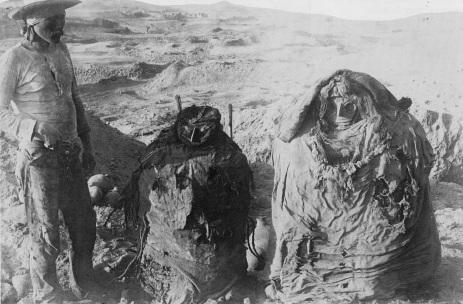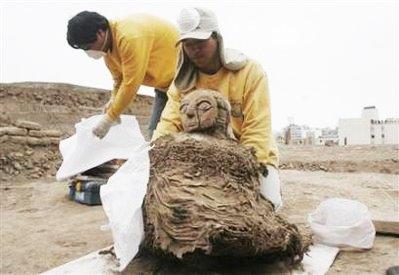The MSU Anthropology department hosted a brown bag featuring Amy Krull, an up and coming scholar in mortuary archaeology from Wayne State University on September 14th. Her presentation was titled “Indoor Archaeology: Funerary Bundles of Ancón”. Krull was in charge of conserving 300 funerary bundles, referred to in the region as fardo or mummy bundles, for the government of Peru. The region of Ancón is located in the Andes, 40 km north of Lima, and presents an interesting dilemma: there are no local artifacts.

Historic Image of two mummy bundles and a workman from Max Uhle’s excavation at Pachacamac, Peru. Penn Museum Image 140697.
The Necropolis of Ancón was first excavated in 1875 by two Germans, Reiss and Stubel. They recovered a number of funerary bundles, and in the process made Ancón a major archaeological zone. Since then they have continued excavations in this region during the 1960′s and 1990′s. It is thought that the necropolis and surrounding domestic sites are related to the Wari takeover in this region. Prior to the rise of the Wari, the Ancon region had small dispersed settlements with singular burials. As the Wari gained strength and influence, the people of Ancon created more central sites around necropoli and started using funerary bundles to commemorate their dead. It isn’t known whether they were a polity or just influenced by trading with the Wari.
The funerary bundles are large textile wrapped individuals. The bundles themselves appear like individuals, with a large circular body and a false head made of textile or wood. Each is fairly idiosyncratic and reflects the cultural region that they came from. There are no bundles indicative of an Ancón culture or tradition. The heads of the individuals are often wrapped in netting, and the bodies are supported by large wooden oars in order to keep them in a tight crouched position.
Krull received the bundles in large burlap sacks, and vary in the number of times that they have been previously examined. A number of them have been x-rayed in order to get details about the individuals within them. Many of the bundles have never been fully opened, and there is an effort to conserve and preserve as many as possible. When the bundle is deteriorating it is excavated to gain as much information as possible before it completely rots away. The bundles when fully opened are a meter by meter, which is perfect archaeological test unit size. Therefore, the study and ‘excavation’ of these bundles proceeds in a manner like an outdoor archaeological unit. When a poorly preserved one is open it appears as organic material from the disintegrated textile and dirt that enters in from the burial. Every single leaf, grain of soil, or object found is kept. Leaves were used to stuff the bundles, and can tell the researchers a lot about the bundles as many of the leaves are from trees not found in the Ancón region.
All of the skeletal remains are examined and analyzed for age, sex, and paleopathology. Skeletal analysis showed that often females are found with infants, trepanation was fairly common, many had external auditory exostoses (a bony ear condition due to diving in cold water) and this funerary practice was used on dogs. No stable isotope analysis has been done to determine the origins of the individuals buried, but future research may reveal this.

Masked female mummy bundle from Lima, Peru, via Ancient Tides
Within the bundles they find numerous textiles as this is one of the primary materials used to create the bundle. They are made of wool, cotton or alpaca, and they can still determine the original color. The textiles have patterns and designs that allow their regional origin to be determined. Often individuals were wrapped 18 to 20 times. However, the closest layer to the human remains was a lace like gauze. Other objects that can be found inside include head netting to hold the hair, bags for holding food or cocoa, ceramics and ear spools or other jewelry. An interesting find from two of the bundles was large wads of cotton fresh from the plants containing the seeds. It isn’t known yet what this means, but further analysis is being done. Most of the artifacts found in these bundles are also non-local, primarily coming from the Chancay culture (800-1400 CE), which is located South of Lima.
Very little analysis of the funerary bundles has been done, so it isn’t quite known who these individuals are. Only one stable isotope analysis using strontium has been done. It tested 34 bundles, and found that 33 of them were from the Ancon region, despite the fact that all the artifacts are from other areas. This poses an interesting conundrum for future research. The work being done on these bundles is still going, and as they excavate more we will hopefully be able to better understand what these burials mean and who these people were.